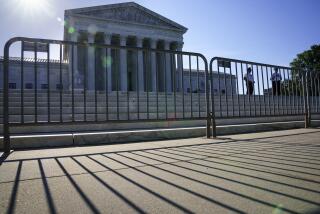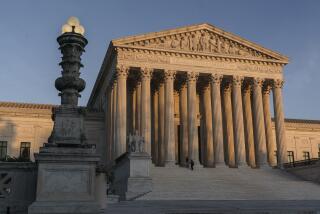To Fill O’Connor’s Shoes, Bush Might Want to Cross the Aisle
In today’s polarized political environment, it may seem inconceivable. But presidents in the past occasionally have found it in their interest to fill Supreme Court vacancies with nominees from the opposition party.
These presidents weren’t naive or altruistic. They recognized such a strategy carried ideological and political costs. But in balancing their interests, they concluded that the benefits of reaching across party lines justified those costs. Their experience offers some relevant precedents for President Bush as he prepares again to replace retiring Supreme Court Justice Sandra Day O’Connor at a moment when polls show his support dwindling outside of his Republican base.
Cross-party Supreme Court nominations have been somewhat more common than many people might expect. Presidents have appointed Supreme Court justices from the opposition party 12 times, according to Congressional Quarterly’s “Guide to the U.S. Supreme Court.”
Republicans, intriguingly, have made more cross-party gestures than Democrats: GOP presidents have appointed nine Democrats to the Supreme Court, while Democratic presidents have named three Republicans. Republican Abraham Lincoln tapped a Democrat to fill a court seat. So did Herbert Hoover. Republican William Howard Taft appointed three Democrats. Democratic presidents Woodrow Wilson, Franklin D. Roosevelt and Harry Truman each appointed one Republican.
Some of these appointees were effectively members of the opposition party in name only. Lincoln’s Democrat, Stephen J. Field, expressed sympathies toward big business that were more common in the GOP. Truman, who picked cronies to fill all four of his vacancies, named a Republican pal who had served with him in the Senate. But other nominations, such as Hoover’s appointment of liberal Benjamin Cardozo, represented genuine concessions to viewpoints outside of the president’s usual coalition.
Three examples seem most relevant to Bush’s situation today.
In 1941, as World War II approached the United States, Roosevelt elevated Republican Harlan Fiske Stone to chief justice. Stone had voted to uphold key elements of the New Deal, but he was a moderate conservative with Wall Street roots who had been placed on the court by Calvin Coolidge. Roosevelt, though, correctly believed that promoting Stone would help unite the country at a time of crisis; one prominent commentator termed the appointment “the perfect word spoken at the perfect moment.”
Truman’s first vacancy offers a different sort of guidance. When Republican Owen J. Roberts announced his retirement in 1945, congressional GOP leaders howled that another Democratic nominee would leave just one Republican on the high court, the smallest number for either party since 1887, as political scientist David Alistair Yalof noted in his book on Supreme Court nominations, “Pursuit of Justices.” Truman, needing help from Republicans as World War II ended, accepted the logic and picked GOP Sen. Harold H. Burton of Ohio.
That wasn’t much of a concession, since Burton was an old buddy of Truman. Dwight D. Eisenhower gave more ground when he filled a vacancy that opened at the height of his 1956 reelection campaign. As Yalof found, Eisenhower thought he could broaden his political appeal by reaching across party lines, and he encouraged his attorney general, Herbert Brownell, to find someone conservative, Catholic and a Democrat. Two out of three isn’t bad: Brownell came back with William J. Brennan Jr., a Catholic Democrat who proved to be a liberal titan during his more than 33 years on the court.
Much of this history seems directly on point today. Like Truman, Bush faces a lopsided partisan imbalance on the court (if he names a Republican to succeed O’Connor, the GOP will hold seven of the nine seats). Like Eisenhower, Bush could benefit from showing that he’s willing to transcend partisan labels. And like Roosevelt, Bush faces an urgent need to unify a country bitterly divided by war and domestic crisis.
Sheldon Goldman, a judicial selection expert at the University of Massachusetts, said the closest parallel to Bush’s situation was Roosevelt’s logic when he elevated Stone explicitly for the purpose of promoting unity as war loomed.
“The country today is in a very serious crisis -- fighting a war in Iraq, now facing this terrible devastation from the hurricane -- and it really needs to be unified,” Goldman said. “It would be a most welcome development if he would go across party lines.”
Presidents who follow this route must take care to ensure they can live with their choice; Brennan, for instance, represented too great an ideological reach for Eisenhower, and despite Brennan’s great stature, the president later regretted the appointment. And any consideration of a Democrat by Bush would guarantee resistance from conservatives eager to tilt the court further right. A Bush gesture to Democrats “would be seen as panic -- or that he is willing to offer us up,” says veteran conservative strategist Jeff Bell.
But Bush may find such discontent an acceptable cost for reaching out beyond his core coalition to independent and moderate voters who have soured on him so much in recent surveys that independent pollster John Zogby says Bush now “is president of the Republicans” alone.
Any Democrat would require some ideological concession from Bush. But prospects such as Jose A. Cabranes, appointed by Bill Clinton to the 2nd Circuit Court of Appeals, or even Sen. Joe Lieberman (D-Conn.), might bring judicial philosophies Bush could tolerate. And by compromising ideologically, Bush could make a dramatic gesture of national reconciliation and conceivably improve his own political standing as well.
Bush seems more likely to fill O’Connor’s seat with Jacques Chirac than with a Democrat. But the president might reconsider the experience of predecessors who sometimes used selections for the high court to court their skeptics.
Ronald Brownstein’s column appears every Monday. See current and past columns on The Times’ website at www.latimes.com/brownstein.
More to Read
Get the L.A. Times Politics newsletter
Deeply reported insights into legislation, politics and policy from Sacramento, Washington and beyond. In your inbox three times per week.
You may occasionally receive promotional content from the Los Angeles Times.










